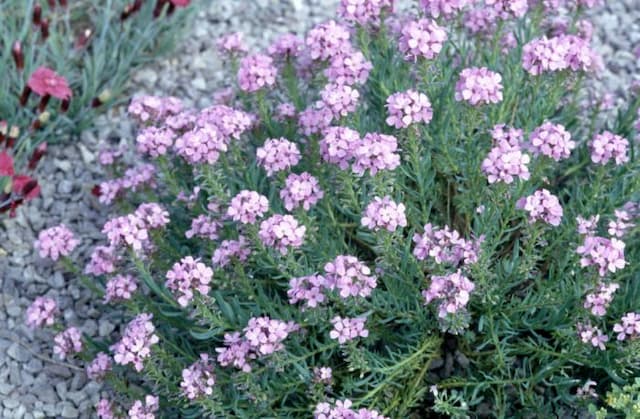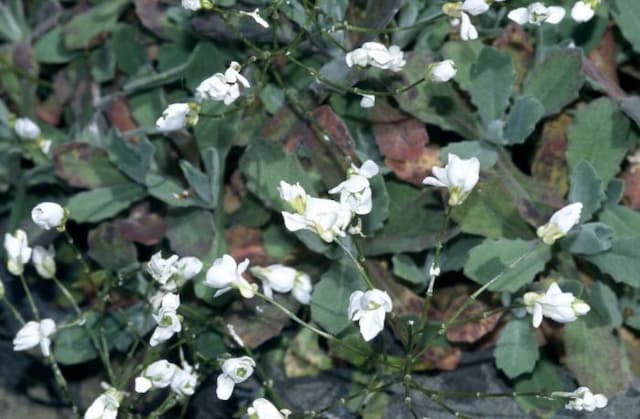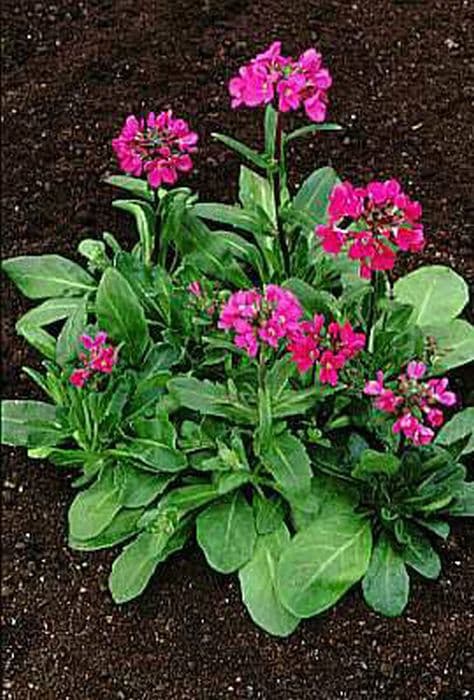Mountain Alyssum Alyssum montanum

ABOUT
Alyssum montanum, commonly known as mountain alyssum, is a perennial plant that is well-known for its charming and vibrant appearance. It displays clusters of small, bright yellow flowers that are highly attractive when in full bloom. The petals of these flowers are tiny and delicate, contributing to a fine texture that can add a soft quality to the landscape. The foliage of the mountain alyssum consists of narrow, lance-shaped leaves that form a dense, low-growing mat. These leaves are typically gray-green in color, which beautifully contrasts the yellow flowers. The leaves are covered with fine hairs, giving them a silvery appearance, especially in the right lighting conditions. Mountain alyssum, with its bright displays and contrasting foliage, is often valued by gardeners for its ability to attract pollinators such as bees and butterflies, which are drawn to its abundant, nectar-rich flowers. Additionally, the plant has a compact and neat growth habit making it a suitable choice for rock gardens, borders, and as an ornamental ground cover. During flowering season, it becomes a centerpiece with its cheerful color and can spread a carpet of yellow over the area it occupies.
About this plant
 Names
NamesSynonyms
Mountain Alyssum, Mountain Gold, Golden Alyssum
Common names
Alyssum gmelinii, Alyssum montanum var. gmelinii, Aurinia montana.
 Toxicity
ToxicityTo humans
Mountain gold is not commonly known to be toxic to humans. There is no substantial evidence indicating that ingestion of this plant causes poisoning in humans. However, as with any plant, individual allergies or sensitivities could potentially cause adverse reactions. It is always prudent to avoid eating plants unless you are certain of their safety and have confirmed that they are edible.
To pets
Mountain gold is not typically known to be toxic to pets such as dogs and cats. Similar to its effects on humans, there are no well-documented cases of poisoning from ingestion of this plant by household pets. Nonetheless, pets may have individual reactions or sensitivities to plants, and it is generally advised to prevent pets from eating non-food plants. If a pet does ingest mountain gold and exhibits any unusual symptoms, it is wise to consult a veterinarian.
 Characteristics
CharacteristicsLife cycle
Perennials
Foliage type
Evergreen
Color of leaves
Grey-green
Flower color
Yellow
Height
0.33 feet (10 cm)
Spread
1 feet (30 cm)
Plant type
Herb
Hardiness zones
4
Native area
Europe
Benefits
 General Benefits
General Benefits- Attracts Pollinators: Alyssum montanum, commonly known as mountain gold, is known to attract a variety of pollinators, including bees and butterflies, which is beneficial for the pollination of nearby plants.
- Ground Cover: It acts as a ground cover, providing soil stability and preventing soil erosion with its dense mat-like growth habit.
- Drought Tolerance: Once established, mountain gold is drought-tolerant, making it a good choice for xeriscaping and low-water gardens.
- Low Maintenance: It requires minimal care once established, with no need for regular watering or fertilization.
- Aesthetic Appeal: With its bright yellow flowers, mountain gold adds a splash of color to rock gardens, borders, and alpine gardens, enhancing the visual appeal of the landscape.
- Wildlife Habitat: It provides shelter and nesting ground for small wildlife and beneficial insects.
- Seasonal Interest: Mountain gold blooms in the spring, bringing early season interest to gardens after the winter months.
 Medical Properties
Medical PropertiesThis plant is not used for medical purposes.
 Air-purifying Qualities
Air-purifying QualitiesThis plant is not specifically known for air purifying qualities.
 Other Uses
Other Uses- Alyssum montanum, commonly known as mountain alyssum, is often used in rock gardens to fill in gaps and create a low-lying carpet effect due to its cascading growth habit.
- In addition to traditional gardens, mountain alyssum can be employed in green roofing projects for its drought-tolerance and ability to thrive in shallow soil layers.
- This plant can serve as a natural ground cover in large landscaping projects, stabilizing the soil and reducing erosion on slopes or embankments.
- Gardeners may use mountain alyssum to attract beneficial insects like bees and butterflies, supporting pollination in the garden ecosystem.
- Mountain alyssum is suitable for container gardening, spilling over the edges of pots and window boxes for ornamental purposes.
- This plant's dense growth can help in weed suppression by covering the ground and limiting the light and space available for weed germination.
- As an ornamental, mountain alyssum is used in floral arrangements to add a delicate and subtle filler among more prominent flowers.
- Mountain alyssum is occasionally planted in cemetery gardens due to its hardiness and low maintenance requirements, offering a serene and respectful ambiance.
- Some eco-friendly artists utilize the small, vibrant flowers of mountain alyssum in plant-based art installations or living sculptures.
- When dried, the flowers and foliage of mountain alyssum may be used in the creation of natural dyes for fabric and craft purposes.
Interesting Facts
 Feng Shui
Feng ShuiThe Mountain Alyssum is not used in Feng Shui practice.
 Zodiac Sign Compitability
Zodiac Sign CompitabilityThe Mountain Alyssum is not used in astrology practice.
 Plant Symbolism
Plant Symbolism- Protection: Alyssum montanum, commonly known as mountain gold, was believed to ward off evil spirits and is often associated with protection and safeguarding.
- Beauty: With its delicate, small flowers, mountain gold represents beauty and the appreciation of minute details in life.
- Humility: Due to its low-growing nature, it symbolizes humility and modesty.
- Tranquility: The plant is often associated with calmness and the bringing of peace to a person's mind and surroundings.
- Endurance: As it can survive in rocky montane environments, mountain gold can symbolize the ability to endure hardships and persevere.
 Water
WaterMountain Alyssum (Alyssum montanum) prefers moderate and consistent moisture levels, so it should be watered when the top inch of soil feels dry to the touch, which may be approximately once a week, depending on environmental conditions. During hotter and drier periods, more frequent watering may be necessary, possibly every few days, but be careful not to overwater, as this plant is drought-tolerant and can be prone to root rot if the soil remains too wet. Aim to provide about 1 gallon of water per plant for each watering session to thoroughly saturate the root zone without leaving standing water.
 Light
LightMountain Alyssum thrives in full sun to partial shade, making it an excellent plant for spots that receive at least 6 hours of direct sunlight each day. It does well in rock gardens, borders, or as a groundcover where it can bask in plenty of light, which is essential for vibrant flowering. However, in extremely hot climates, a bit of afternoon shade will help protect the plant from scorching.
 Temperature
TemperatureMountain Alyssum is a hardy plant that can tolerate a wide range of temperatures but grows best in cooler conditions. It can survive minimum temperatures down to around 10°F and thrive up to 75°F. The ideal growing temperature range is between 60°F and 70°F, where it produces the most robust growth and bloom.
 Pruning
PruningPruning Mountain Alyssum encourages bushier growth and more prolific blooms. Deadheading spent flowers will prompt further blooming throughout the growing season. Lightly trim back the plants after the first flush of blooms has finished to maintain a compact shape and encourage a second bloom. The best time for pruning is usually mid-summer, after the peak of the first blooming period.
 Cleaning
CleaningAs needed
 Soil
SoilMountain Alyssum requires well-draining soil with a neutral to slightly alkaline pH between 7.0 and 7.5. A recommended soil mix for this plant includes equal parts of garden soil, coarse sand or perlite, and compost or well-aged manure to enrich the soil.
 Repotting
RepottingMountain Alyssum is a perennial that typically does not require frequent repotting. Repotting can be done every 2 to 3 years, or as needed if the plant outgrows its container or the soil becomes depleted.
 Humidity & Misting
Humidity & MistingMountain Alyssum prefers a dry to moderate humidity level and tends to thrive in open areas with good air circulation, rather than humid environments.
 Suitable locations
Suitable locationsIndoor
Place Mountain Alyssum near a sunny window; ensure good air flow.
Outdoor
Choose a sunny spot with well-draining soil for Mountain Alyssum.
Hardiness zone
3-7 USDA
 Life cycle
Life cycleAlyssum montanum, also known as mountain gold, is a perennial plant that begins its life cycle as a seed, which can survive the winter cold and germinate in the early spring. Upon germination, the seedlings emerge and develop into rosettes of leaves close to the ground in their first growing season. As the plant matures, it produces a flowering stem the following spring, where small, bright yellow flowers develop and bloom to attract pollinators. After pollination, these flowers produce fruit in the form of silique capsules containing seeds for the next generation. During the summer, when the plant has finished flowering, it enters a period of dormancy where above-ground growth dies back, while the root system remains alive. The cycle repeats each spring as the plant regrows from the rootstock and produces new flowering stems, continuing to spread and populate the area.
 Propogation
PropogationPropogation time
Spring to Summer
Mountain Alyssum is commonly propagated through seeds. The best time to sow Mountain Alyssum seeds is in spring after the danger of frost has passed. To propagate, seeds should be scattered lightly onto the surface of well-draining soil and not covered, as they require light for germination. They typically germinate within two to three weeks at temperatures between 65 to 70 degrees Fahrenheit (18 to 21 degrees Celsius). Once seedlings have emerged and are large enough to handle, they can be transplanted to their final growing position, ensuring they are spaced about 6 to 8 inches (15 to 20 centimeters) apart to allow for ample growth.





![Aubrieta [Axcent Burgundy]](/_next/image?url=https%3A%2F%2Fplants-admin.emdemapps.com%2Fimages%2Fplants%2F%2Fimages%2F604b5b7b548d8.png&w=640&q=75)



